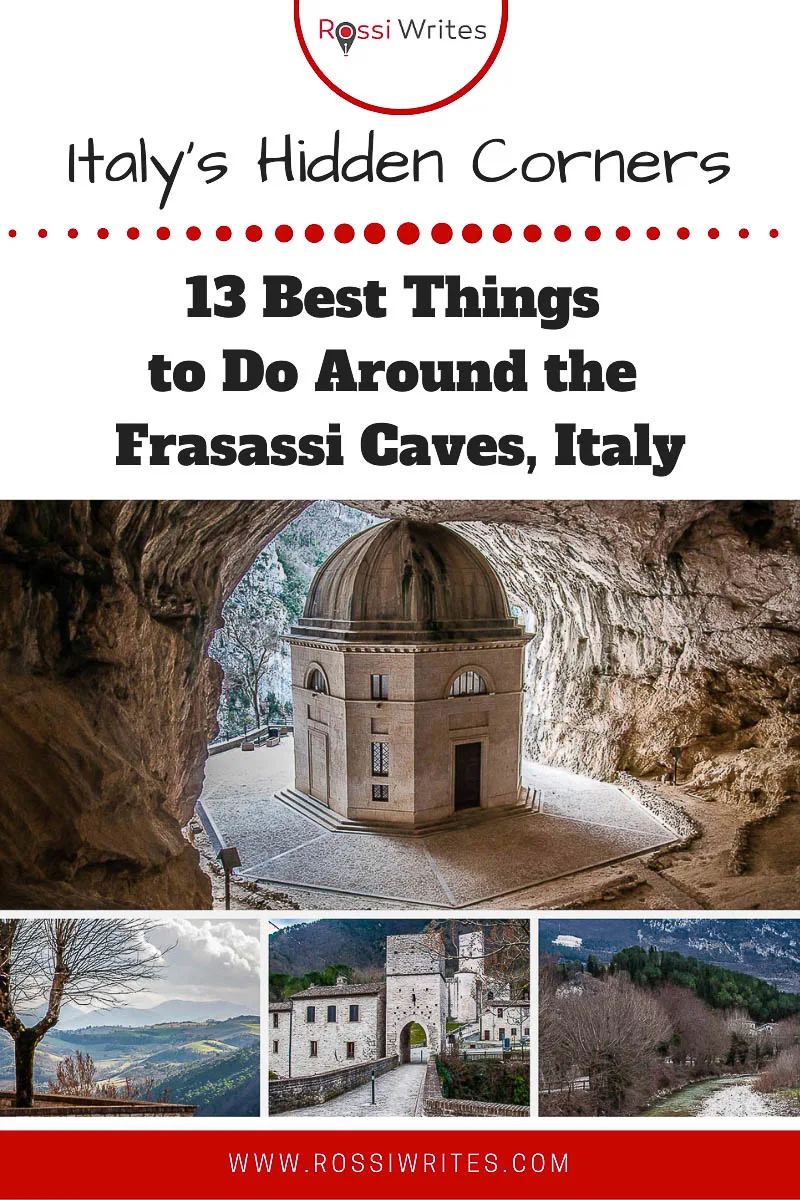The stunning Frasassi Caves are a must-see destination in Italy.
Millions of years old and with subterranean chambers dotted with whimsical formations and small lakes, visiting the caves leaves you with memories to last a lifetime.
The best thing about the Frasassi Caves though is that you don’t have to travel just to see them. The area around the caves is rich in sights of natural beauty, hiking and rock climbing opportunities, medieval walled villages, spa procedures where the Ancient Romans once came to bathe, museums with priceless art and artefacts, and even a thousand years old hermitage and an octagonal temple built in a cave mouth.
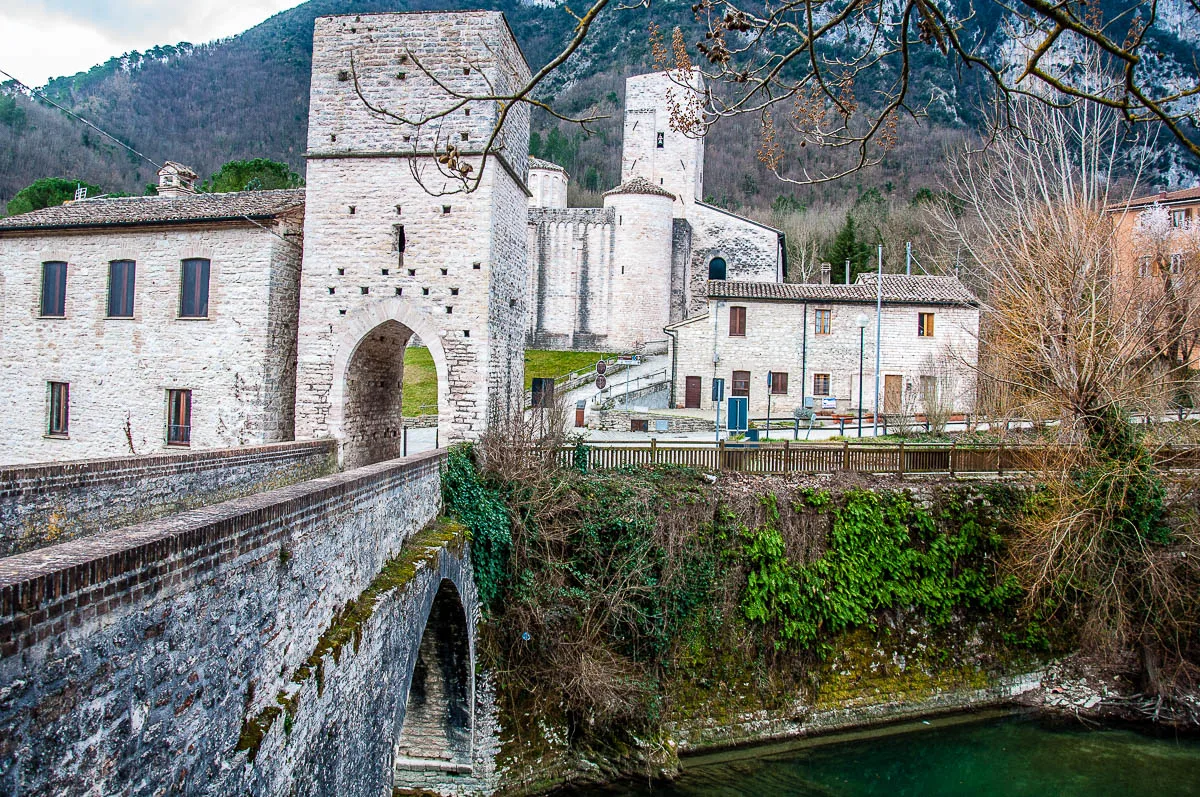
All in all, around the Frasassi Caves you will find all the ingredients for a great day out or a multi-day exciting stay. Set in the Gola della Rossa and Frasassi Regional Natural Park in the Central Italian region of the Marche, the Frasassi Caves are easy to travel to by car and train from many large Italian cities, including Italy’s capital – Rome.
If you click on this link, you will find exhaustive information about how to visit the Frasassi Caves and what makes them a must-see sight in Italy. In addition, in this blog post today, I will share with you the 13 best places to see for yourself around the caves. This way, you can easily plan your trip and fill your time at the Frasassi Caves with many exciting things to do.
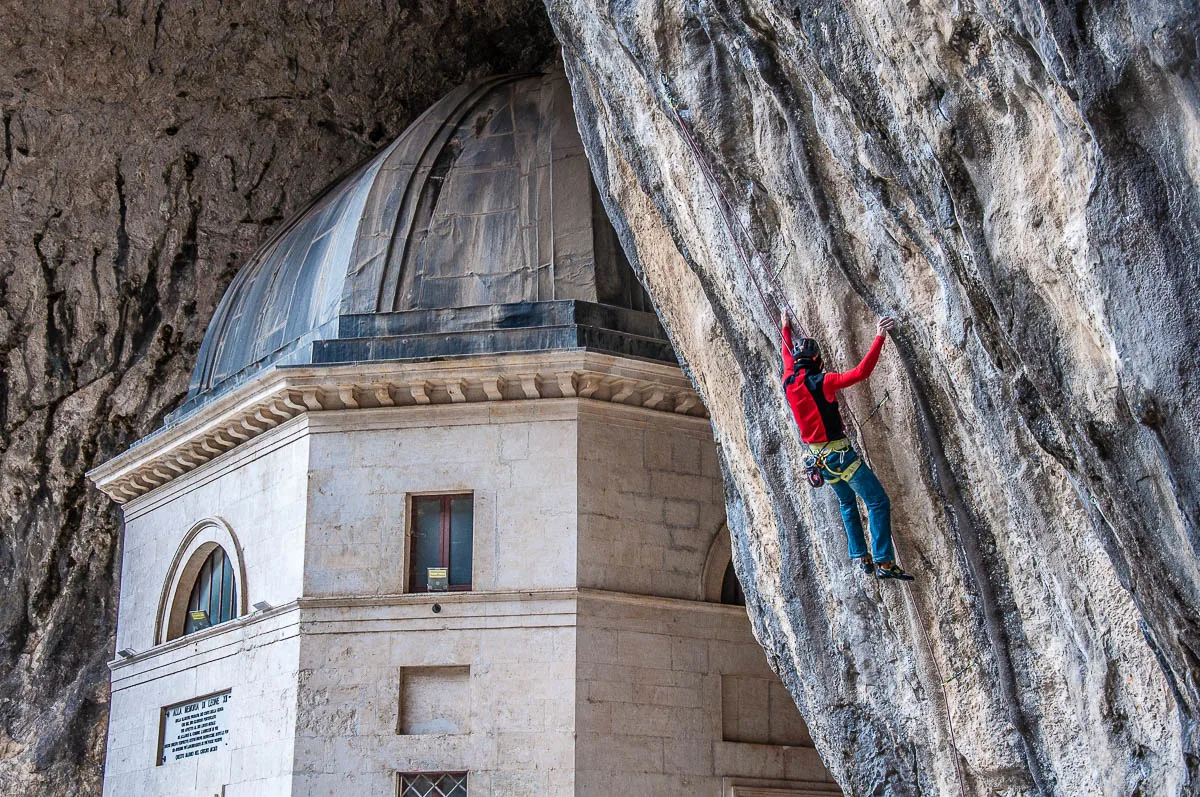
Ticking them off one by one will give you a great insight into the history of the Frasassi Caves, the people who lived around them since prehistoric times, and even the legends and traditions that were shaped in the area during the Middle Ages. It will also allow you to get in close contact with the beauty of nature and admire some soul-inspiring views. Above all, you will have the chance to explore for yourself a hidden and authentic corner of Italy and that’s a great reason in itself to head there as soon as possible.
Now, without further ado, let’s start!
13 Best Things to Do Around the Frasassi Caves, Italy
1. Gola della Rossa and Frasassi Regional Natural Park
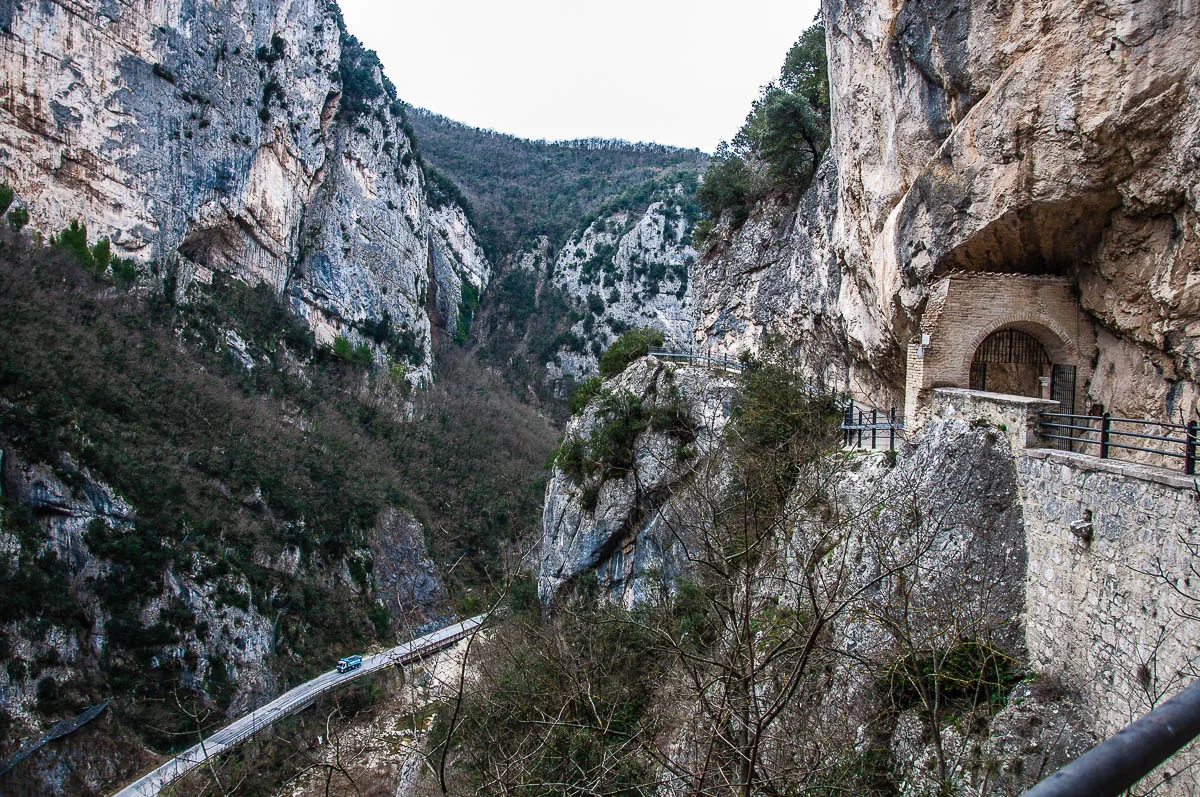
Gola means gorge in Italian and in this beautiful natural park in the Central Italian region of the Marche, you have two of them. The Gola della Rossa and the Gola di Frasassi have steep rocky walls and traces of human activity since prehistoric times. The River Sentino cuts through the Frasassi Gorge before flowing into the River Esino which flows for part of its journey through the Rossa Gorge.
The entrance of the Frasassi Caves is on the side of Monte Valmontagnana – one of the natural walls of the three km long Frasassi Gorge. Whilst this is the most well-known cave system here, the area as a whole has over 100 natural caves and cavities. Prehistoric and protohistoric communities lived in some of them and used others for practices related to the cult of the dead as well as for symbolic and magical-religious rituals. In their minds, these ancient people identified the caves with the womb of the Earth and/or as the entrance to the afterworld. So, they were great places to perform fertility rites, to practice the cult of the waters, and to place the dead.
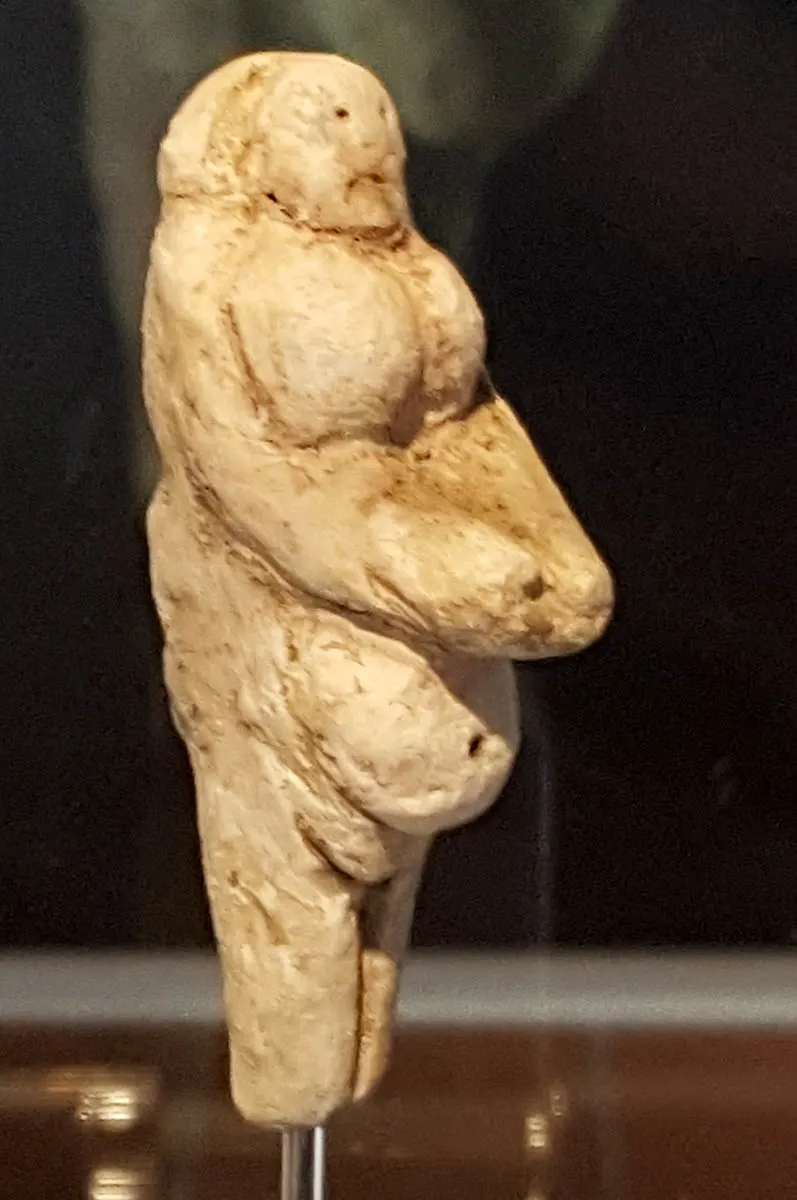
The Frasassi Venus is the most important artefact from that period. This is a small figure of a woman carved out of a stalactite. It was found in the Cave of the Blessed Virgin of Frasassi (see point 9 below) which is less than a kilometre up the road from the Frasassi Caves. In the mouth of this cave nowadays you can see the Temple of Valadier (see point 10 below) and the Hermitage of Santa Maria Infra Saxa (see point 11 below).
Just over eight cm tall, the Frasassi Venus has a rounded body with large breasts and swollen belly. Similar in shape to other Paleolithic Venuses (made between 28,000 and 20,000 years ago), it may have been used as a fertility amulet or a representation of a goddess mother.
Nowadays, the Gola della Rossa and Frasassi Regional Natural Park is a great place to head to if you love hiking or want to test your rock climbing skills. Lovingly referred to as the Marche’s green heart, the park’s uncontaminated nature is home to 105 species of nesting birds (from Royal Eagles to Tawny Owls) and over 1250 plant species. Wild boars, bucks, deer, wild cats, and badgers live in the park, too.
The circular trail Il Sentiero dell’Aquila (The Path of the Eagle) is a particularly beautiful hike you can do here. About seven km long, it takes you around the summits of the northern side of the Frasassi Gorge. Ten informational billboards have been placed along the way giving you details about the history, geology, and biology of the places that the hike goes through. The trail follows ancient roads that connected the small medieval villages in the area for centuries until the road that goes through the gorge was built in 1912.
Sulfuria is another interesting spot in the Frasassi Gorge. It is famous as rock climbers’ central and a place where rock climbing festivals and events take place.
For specific hikes in the area, please, have a look at the official website of the Gola della Rossa and Frasassi Regional Nature Park. It’s in Italian, so you can use Google Translate to orient yourself. In addition, you can ask for maps, directions, and guides at your accommodation and the local tourist offices.
Please, exercise maximum caution and common sense when out hiking. Don’t enter caves and cavities without proper equipment, caving skills, and a local guide.
2. Abbey of San Vittore delle Chiuse
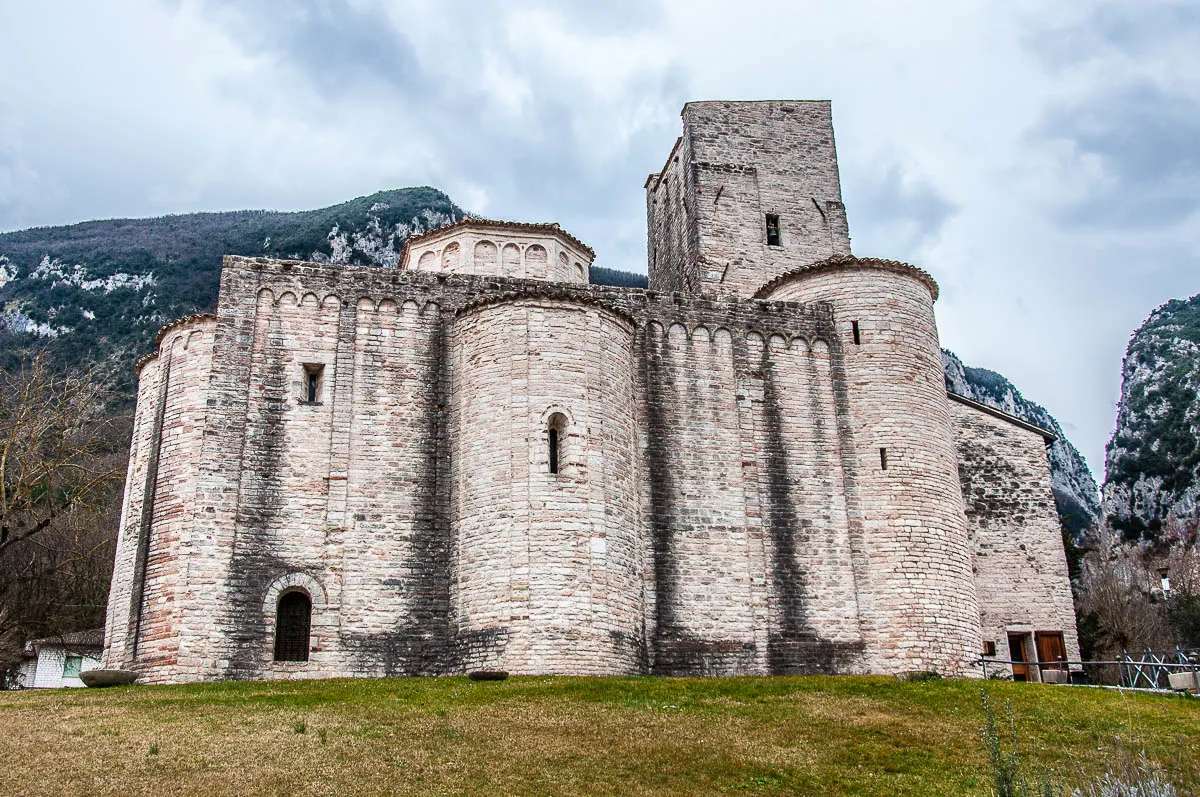
The Abbey of San Vittore delle Chiuse is the closest to the Frasassi Caves sight to see on the same day that you visit the caves. You will glimpse its Romanesque architecture from the shuttle bus that will take you from the car park around the Frasassi Caves’ ticket office to the caves’ actual entrance about two km away.
On the way back from the Frasassi Caves, the shuttle bus stops in front of the Abbey of San Vittore delle Chiuse to allow people to visit it together with the other sights in the small hamlet of San Vittore in which the abbey stands.
First mentioned in 1007 AD, the abbey is undoubtedly much older than that. In the past, it was one of the most important abbeys in the Marche and was in charge of several castles and over 42 local churches.
The tall severe building of the Abbey of San Vittore delle Chiuse contrasts beautifully with the green hills that serve as its dramatic backdrop. The sturdy bell tower seems to have performed defensive functions in the past thus making the church appear a curious mix between a place of worship and a walled up castle.
A quick visit inside is recommended to admire the strong architectural lines and to appreciate the austere character of the place. You may be surprised to see that the large church is bare inside. Unlike most Italian churches and temples, there are no frescoes or other decorations on the walls here. Hence, your eyes are immediately drawn to the semi-circular arches that link the monumental pillars high above your head.
3. Speleo-Paleontological and Archaeological Museum
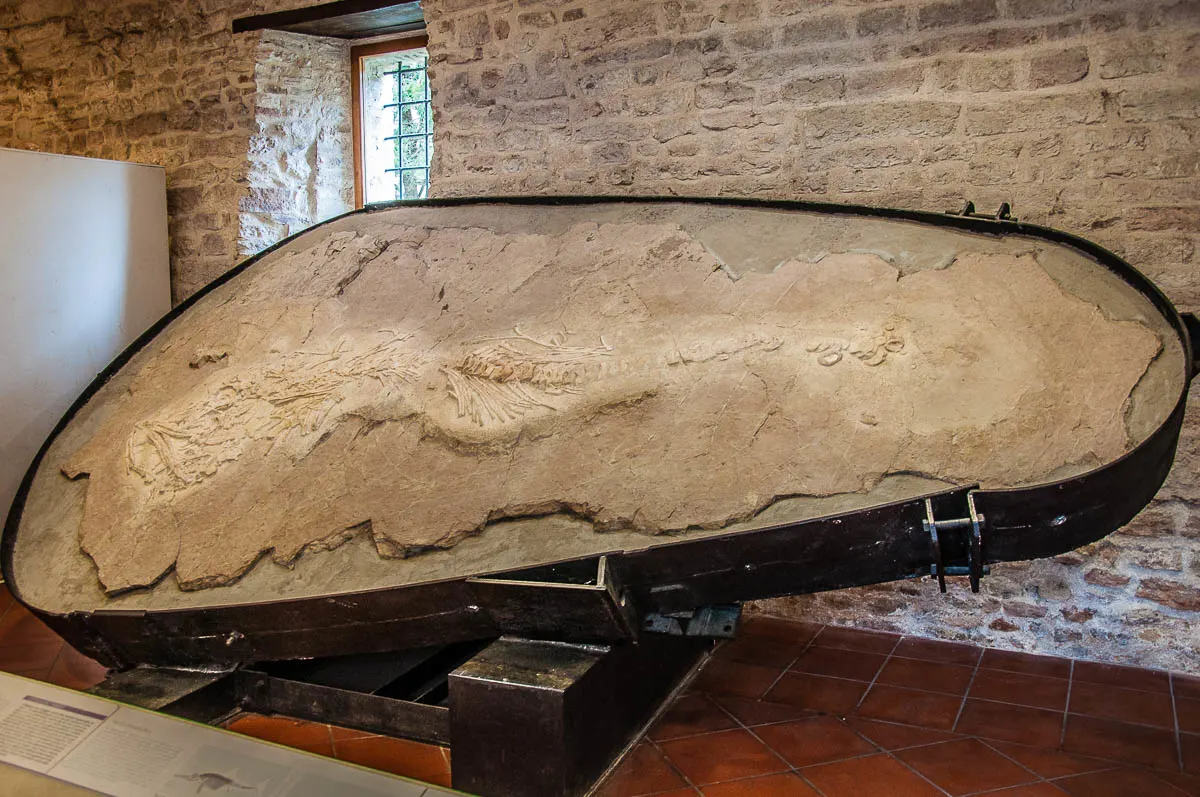
Right behind the Abbey of San Vittore delle Chiuse you will see the annexe where the monks once lived and which nowadays functions as a small speleo-paleontological and archaeological museum. A visit won’t take you more than half an hour, yet the museum has some very interesting artefacts. Plus, admission is included in the price of the ticket for the Frasassi Caves.
The museum has three floors:
- One is dedicated to the geological formation of the Frasassi Gorge and the underground chambers of the Frasassi Caves.
- Another hosts a small paleontological section. The star here, without a doubt, is a fossilised Ichthyosaurus – an ancient marine reptile which would grow to 3.5 m in length.
- The last section is where you can admire archaeological findings dating back to protohistoric times and found in the vicinity of the village of Genga (see point 7 below). A special interest deserve the funerary urns from the Pianello Necropolis dating back to the 12th-10th centuries BC.
In this museum, you can also admire a copy of the skeleton of a cave bear – a long-extinct mammal and relative to the brown bear which had an almost fully vegetarian diet and which was competing with humans for living space in caves.
My favourite artefact here is an ancient grater which looks remarkably like the ones we use to grate cheese nowadays.
4. Roman Bridge over the River Sentino
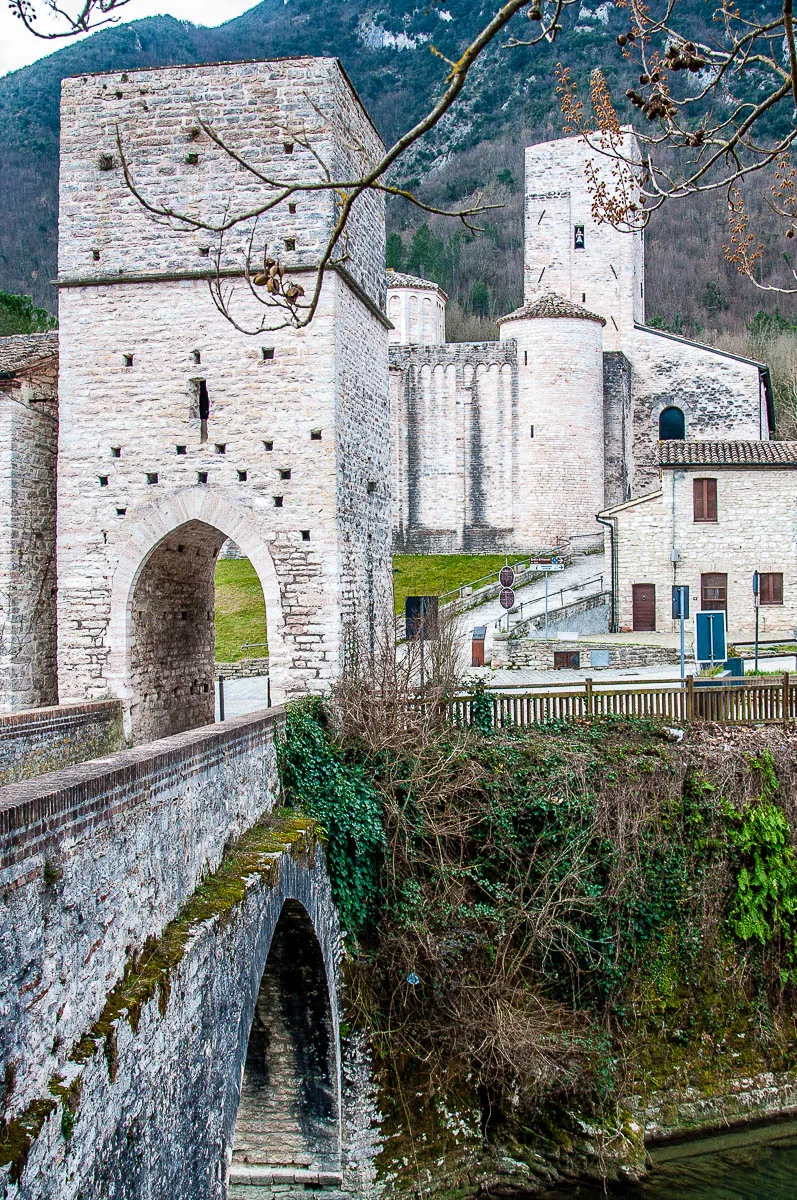
Just across the road from the Abbey of San Vittore delle Chiuse in the small hamlet of San Vittore near the Frasassi Caves, you can cross an authentic Roman bridge stretching over the River Sentino.
Made of sturdy stones, the bridge is quite curious in so that its arch is rounded on one side and pointy on the other. The fortified tower at the end of the bridge is of medieval origins.
Stop on the Roman bridge for a minute or two and look at the River Sentino below. Its teal waters are crystal clear and you can glimpse large fish going about their daily business. You will notice that the river also smells of rotten egg – the typical aroma of sulphurous waters which are much prized locally for their therapeutic and curative properties.
5. Terme di Frasassi
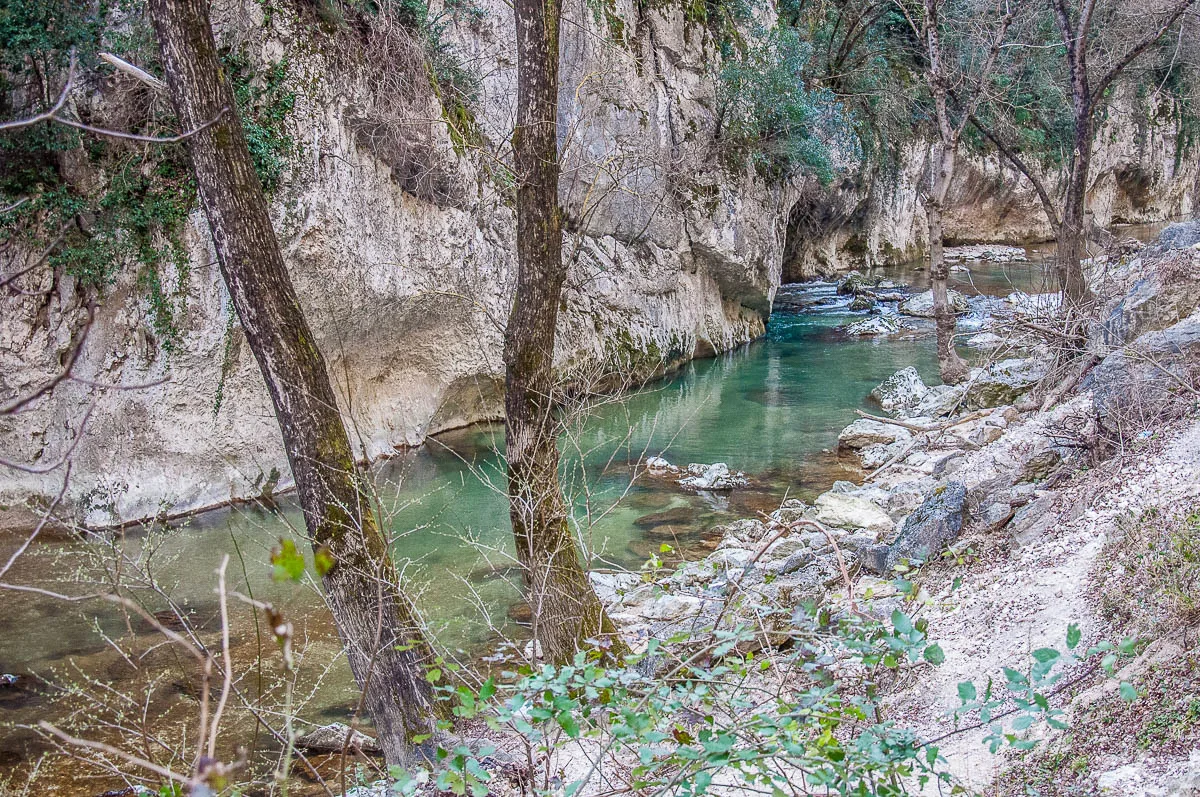
Millions of years ago, sulphurous waters springing from earth’s depths led to the formation of the Frasassi Caves (see the very abridged history of the caves here for further details). Once their job was done underground, they resurfaced near the small hamlet of San Vittore.
The ancient Romans – famous for their spa habits – made full use of these sulphurous mineral waters. They soaked and bathed in them seeking to restore their health and vitality.
Nowadays, the spa tradition here continues in the shape of a modern spa hotel – Terme di Frasassi – offering all sorts of procedures using the local thermal mud and mineral waters.
6. Parco Frasassi Avventura
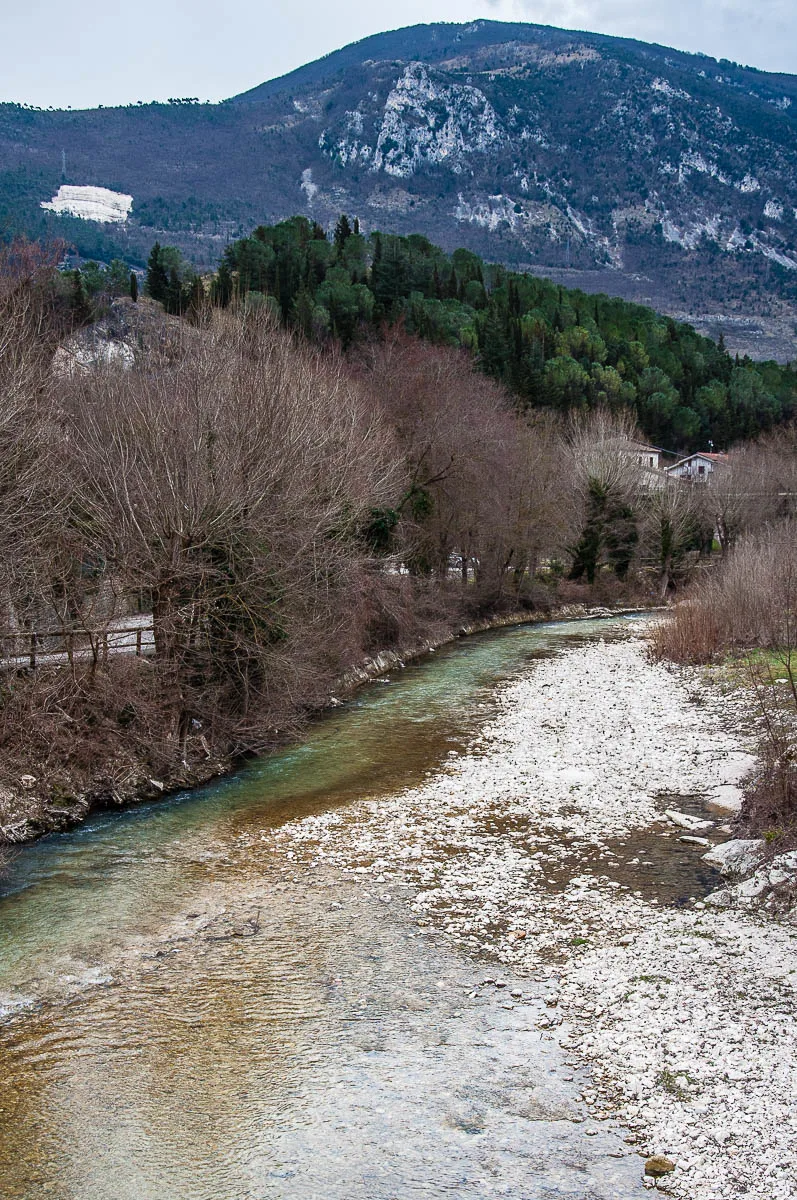
Just a few steps away from the hamlet of San Vittore and the large car park around the Frasassi Caves’ ticket office, you will find the adventure park Parco Frasassi Avventura.
Here adults and kids can have moments of fun on the zip lines and treetop walkways right next to the impossibly teal River Sentino.
Next to the park stands a famous local restaurant called La Cantina where you can sample traditional for the Marche dishes, wines, and artisan beers.
Unfortunately, when we visited the Frasassi Caves and the adjacent area, the Parco Frasassi Avventura was closed as it was the low season. To avoid disappointment, please, check the official website for up to date opening times.
7. Genga
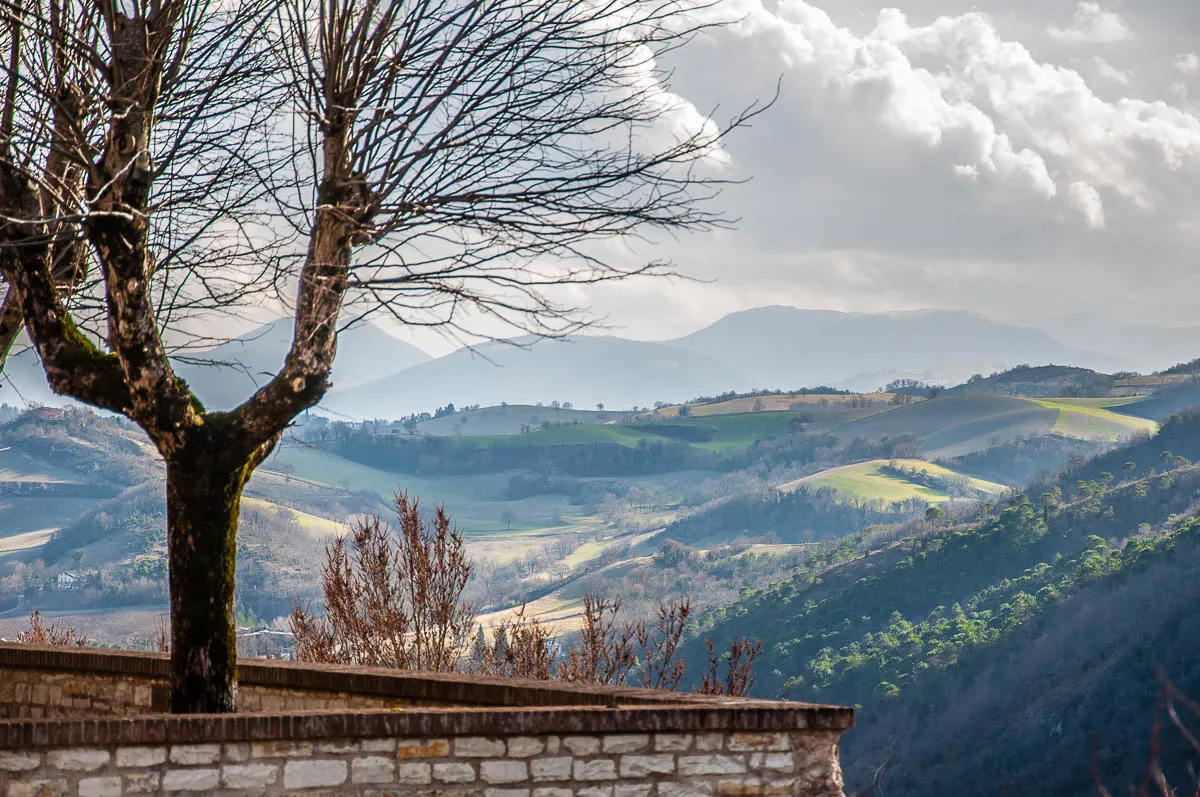
Genga is a hilltop village in the Frasassi Gorge. It’s just over seven km away from the hamlet of San Vittore. The easiest and quickest way to reach it is by car although you can also take public transport (train and then bus).
Tiny and cute, Genga grew through the centuries inside the defensive walls of a medieval castle. Its origins stretch back in time and are linked to the Abbey of San Vittore delle Chiuse (see point 2 above) and the nearby village of Pierosara which was known as Castellum Petrosum in the Middle Ages (see point 12 below).
The first document (that has reached us) mentioning Genga’s name dates back to 1090. In it, the Abbot of the Abbey of San Vittore delle Chiuse leased the castle to Ugo, Alberto, and Suppo – the sons of the feudal Count Alberico. Their descendants ruled Genga and the adjacent territories from the 11th until the 18th centuries and were known as the Counts of Genga.
Their most famous descendant was Pope Leo XII. He was born in Genga on 2nd August 1760 as Annibale della Genga. Destined for a religious career, he became a brilliant ecclesiast and diplomat, taking different missions in Europe and then serving at ever higher posts in the Vatican. He became Pope on 29th September 1823 until his death on 10th February 1829. During his life, he made several important religious and art commissions in the area around Genga. Most notably, he was the driving force for the building of the Temple of Valadier (see point 10 below).
Genga truly is pocket-size. It can be easily explored with all that there is to see there in about an hour or so. Its tall houses are made of the local pink and white limestone. They have small windows and plain facades blending into the rocks and the defensive walls which still surround the village.
Come here to see an authentic medieval hilltop village where life doesn’t seem to have changed much over the last centuries. Enjoy the stunning views that open in front of your eyes. In addition, don’t miss the two main points of interest here:
- Church of Santa Maria Assunta – a Baroque building dating back to 1630. This is where the future Pope Leo XII was baptised. Inside you can see works by local painters, the most important of which is the big canvas ‘Madonna with the Infant Jesus, St. Clement and St. Stephen’ by Ercole Orfeo Presciutti – a painter from the city of Fano in the Marche. Previously this painting was in a church in Rome and it was donated to Genga by Pope Leo XII.
- Palace Fiumi-Sermattei – which nowadays houses the Museum of Art, History, and Territory (see point 8 below).
8. Genga’s Museum of Art, History, and Territory
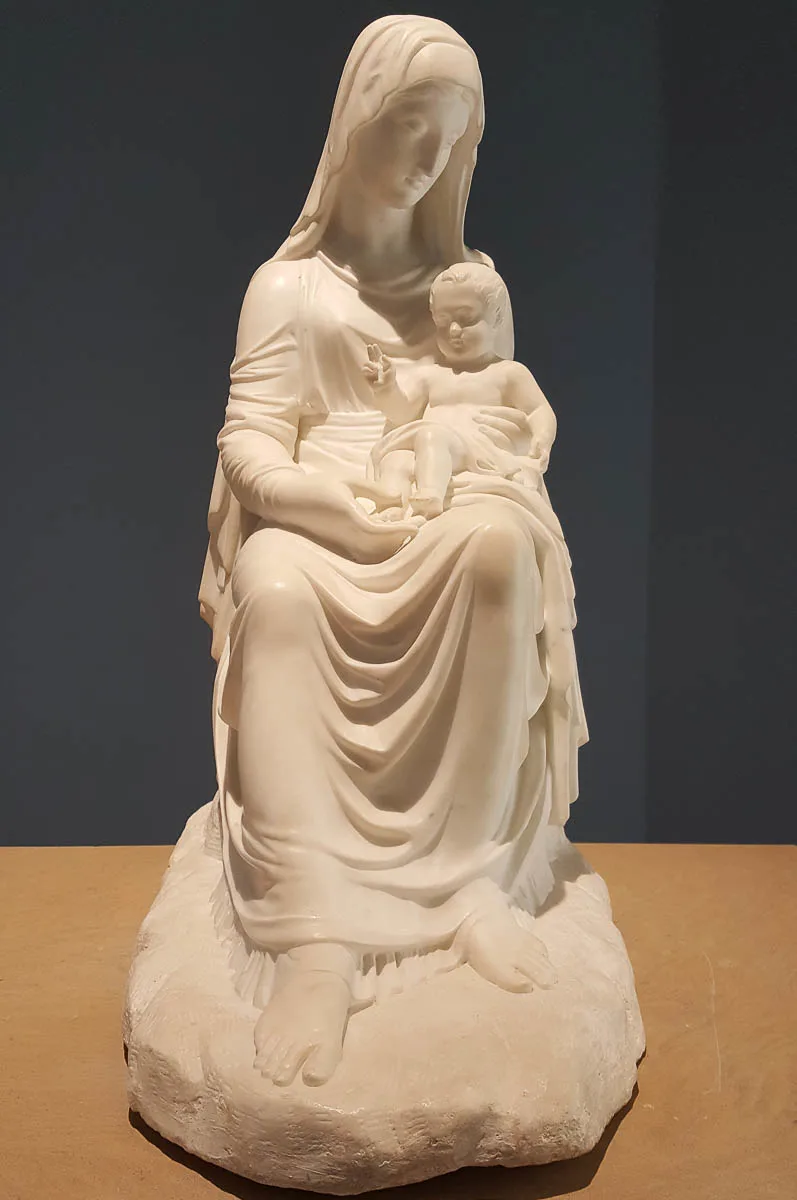
Although small, the village of Genga has a very interesting history from cultural, archaeological, and geological points of view. You can trace it all through local artefacts, paintings, sculptures, and photos in the excellent Museum of Art, History, and Territory which has been installed in the Palace of Fiumi-Sermattei right in Genga’s heart.
A visit is a must to truly appreciate the area’s heritage and the genesis of the Frasassi Caves. Plus, admission is included in the price of the ticket for the Frasassi Caves.
The two main exhibits here – connected through their spiritual dimension although separated by thousands of years in time – are:
- Frasassi Venus – the small figurine of a rotund woman the story of which is covered under point 1 above. Between 20,000 and 28,000 years old and found in the Cave of the Blessed Virgin of Frasassi, the Frasassi Venus is one of Italy’s oldest and most precious representations of Paleolithic art. Its archaeological value is such that nowadays the Frasassi Venus is held in the Archaeological Museum of Marche in Ancona. The museum in Genga instead has a perfect reproduction of the figure which is the central exhibit in a room exploring the geology and the history of the Frasassi Gorge and the caves in it.
- Madonna with Child – a marble image of the Holy Mother carved in the workshop of the renowned Neoclassical sculptor Antonio Canova. Originally made for the altar of the Temple of Valadier in the Cave of the Blessed Virgin of Frasassi (see respectively points 10 and 9 below), this small sculpture nowadays is kept safely in the museum in Genga while a faithful copy takes its place at the temple’s altar.
Other exhibits of interest here are the paintings by the Early Renaissance artist Antonio da Fabriano, the 16th-century Statute of the Castle of Genga, as well as artefacts referring to the life and religious service of Pope Leo XII.
The most curious thing to see here, in my own opinion, is the wax figure of a Christ Child. Starting from the Middle Ages, such figures – made of wax or wood and dressed in rich fabrics and adornments – used to be given by parents of aristocratic families to girls about to be married as a symbol of the motherhood they were expected to fulfil. However, they were also given to girls destined to become a nun as a replacement of the motherhood that was never to happen.
9. Cave of the Blessed Virgin of Frasassi
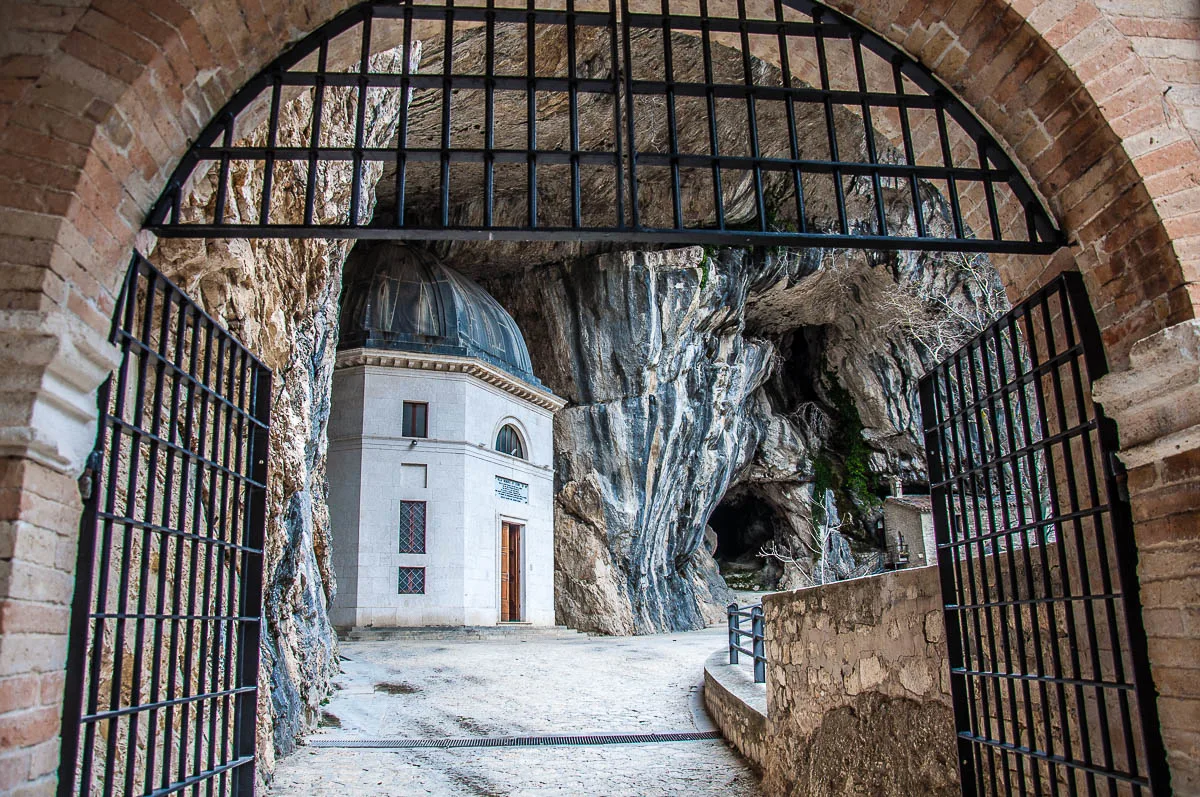
From an archaeological point of view, this is the most important cave in the Frasassi Gorge. Known as the Cave of the Blessed Virgin of Frasassi, it is often also referred to as the Cave of the Sanctuary or simply as the Frasassi Cave.
This has led to many wrong assumptions that this cave is part of the Frasassi Caves and that the Temple of Valadier, which is in the mouth of the Cave of the Blessed Virgin of Frasassi, is right next to the tourist entrance of the Frassasi Caves.
This is not so!
The Cave of the Blessed Virgin of Frasassi is under a kilometre up the road from the Frasassi Caves. Also, while the Frasassi Caves are inside Mount Valmontagnana, the Cave of the Blessed Virgin of Frasassi is inside Mount Frasassi. Mount Valmontagnana and Mount Frasassi are on the opposite sides of the Frasassi Gorge.
So, to avoid any confusion, here I use the full name of the Cave of the Blessed Virgin of Frasassi. It’s long but it makes it clear that I am referring to a completely different cave than the Frasassi Caves.
The Cave of the Blessed Virgin of Frasassi has provided shelter to humans since Neolithic times. First, travellers coming from Southern Italy would stop there on their journeys. Later on, the cave was used for funerary rites and magical-religious rituals. The cave’s wide mouth provided much-needed light. A natural water spring trickled nearby. This made the cave perfect for the prehistoric and protohistoric communities who passed through and lived in these lands. The cave remained in use during Roman times all the way to the Middle Ages.
The cave’s inner room has many lateral corridors and it was used as a funeral area. Explorations have found groups of vessels laid along the walls, jars and cups containing burnt remains, as well as a bronze dagger and a button made of blue faience protecting a conical tomb. This is also the cave where the Frasassi Venus was discovered in 2007.
To reach the Cave of the Blessed Virgin of Frasassi, you need to drive for a couple of minutes or so up the Frasassi Gorge. There is a small parking area on the side of the hill where you can see informational boards and a statue of Pope Leo XII.
A wide, easy to navigate path starts from here and leads you up the slope of the hill for about 700 m to the cave’s mouth.
Along the way, you will see the area where Genga’s Living Nativity Scene takes place each December. Staging Nativity Scenes with hundreds of participants recreating ancient Bethlehem in minute detail is a favourite pastime for whole communities in Italy at Christmas. Genga’s Living Nativity Scene also claims to be the longest in the world.
From the path beautiful views open over the Frasassi Gorge and the surrounding steep hills. A bench is provided at a particularly picturesque spot for you to stop and take all that beauty in.
At the end of the path, you will see the cave’s mouth with the impressive Temple of Valadier (see point 10 below) and the thousand years old Hermitage of the Santa Maria Infra Saxa (see point 11) standing in it.
10. Temple of Valadier
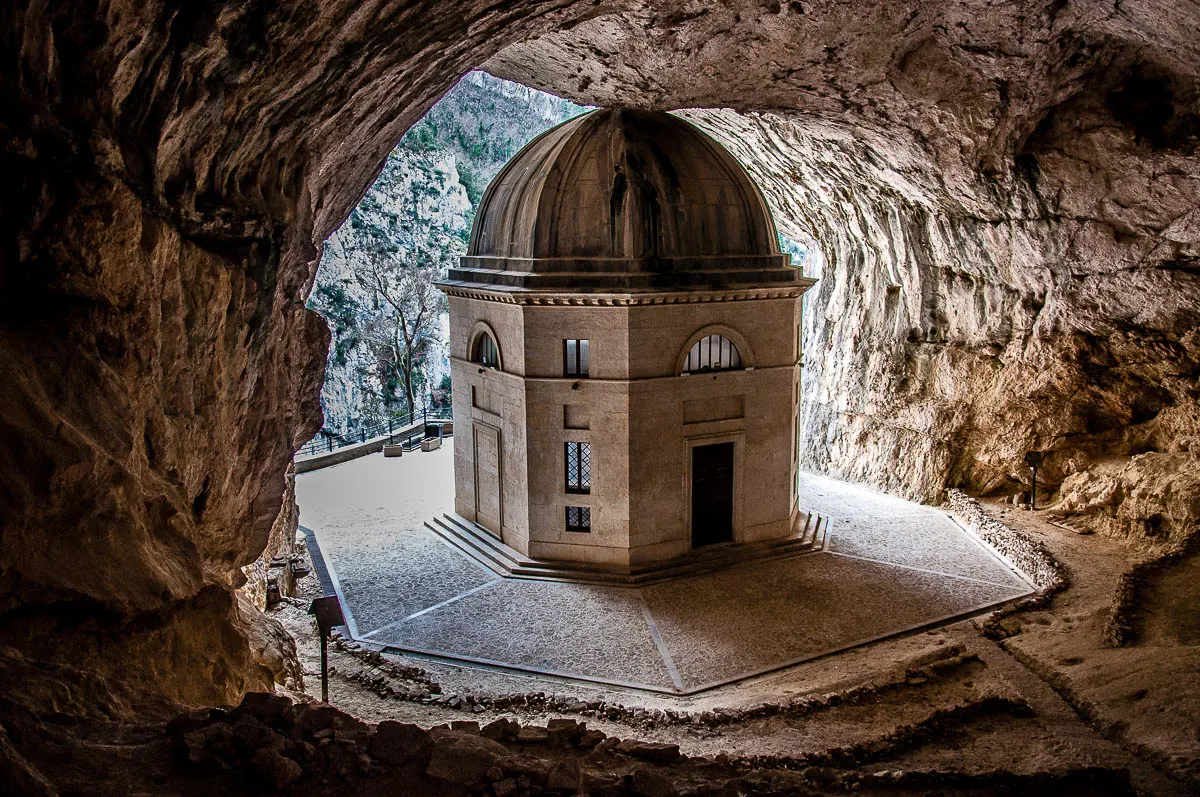
On account of its stunning location and octagonal shape, personally, for me, the Temple of Valadier is the most beautiful and interesting sight not to be missed near the Frasassi Caves, Italy.
Built under the commission of Cardinal Annibale della Genga (future Pope Leo XII), the temple was inaugurated in 1828. It stands in the mouth of the Cave of the Blessed Virgin of Frassasi, just under a kilometre away from the Frasassi Caves.
The temple’s smooth walls contrast perfectly with the rugged, rough walls of the cave. Its domed roof is designed to flawlessly slot underneath the cave’s ceiling. When you look at it, it seems to expand and grow thus it creates the illusion that it’s about to perforate the cave and protrude above it.
The temple is known under the name of the renowned Roman architect Giuseppe Valadier. For close to two centuries it was thought that he had designed the temple. New research has now discovered that in fact there were three architects working on it – Pietro Ghinelli, Tommaso Zappati, and Carlo Donati. Of them, Ghinelli was in direct contact with Valadier during his work on the temple which may have led to the misnaming.
The resulting Neoclassical building is octagonal in shape in celebration of the symbolic meaning of the number eight. It refers to the eighth day – after the seven of the Creation – when life on Earth began in earnest.
The Temple of Valadier has many doors and windows to maximise the flow of light within the dim surroundings of the cave. Apparently, these used to be kept open during mass to allow the many pilgrims visiting the temple on festive days to follow the proceedings inside.
The interior of the Temple of Valadier is rather spartan. On its altar, you can see a small sculpture of the Virgin cradling the Infant Jesus. Carved of white marble, the sculpture is by the Roman workshop of Italy’s most famous Neoclassical sculptor – Antonio Canova. Nowadays, the 19th-century original is kept at the Museum of Genga (see point 8 above) and a copy remains in the Temple of Valadier.
11. Hermitage of Santa Maria Infra Saxa
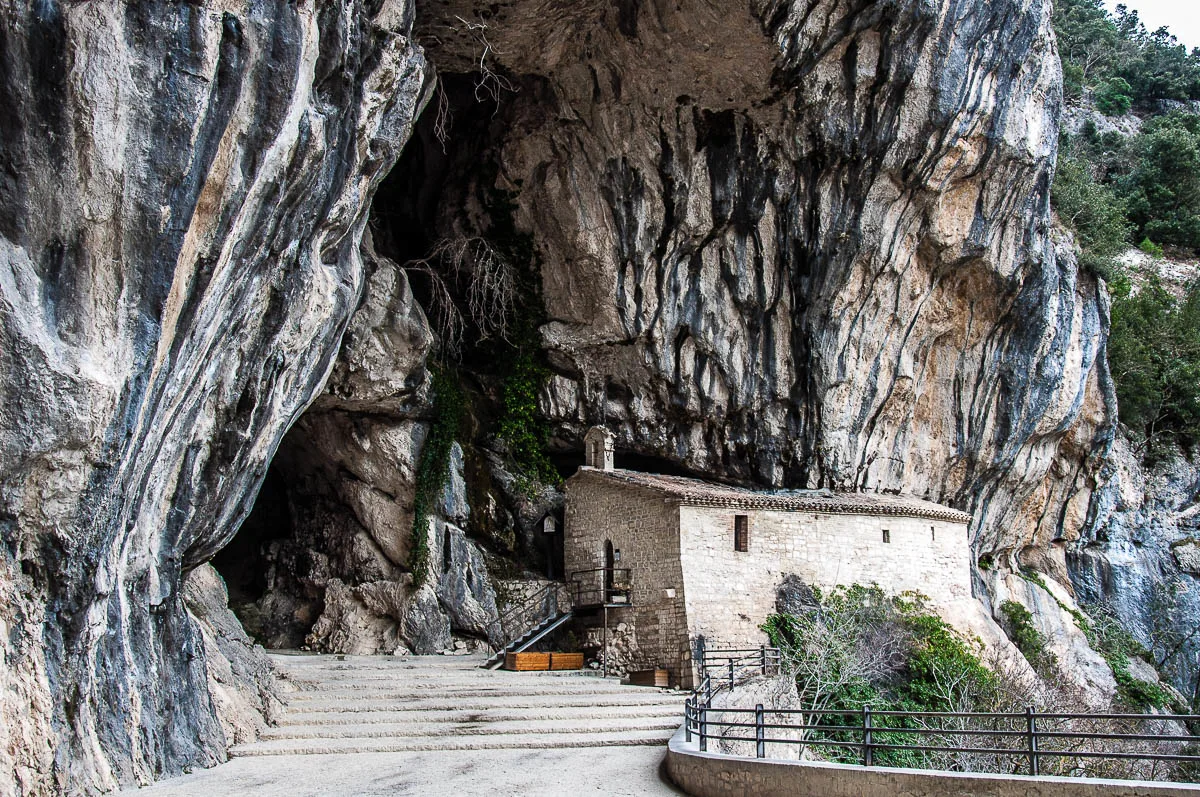
Just a few steps away from the Temple of Valadier stands the small Hermitage of Santa Maria Infra Saxa. More than one thousand years old, it’s built against the wall of the cave. The freshwater spring that first attracted the prehistoric communities to this area is near the hermitage.
The hermitage was first cited in a document in 1029. It was set up by Benedectine nuns. They lived there in isolation and prayed in front of a miraculous wooden image of the Madonna with Child placed in a niche carved in the cave’s wall. Unfortunately, in 1947 the image burnt in a fire started by a votive candle. It was then replaced with a stone copy which can be seen in the hermitage today. Candles are no longer allowed there.
To enter the hermitage you need to go up a metal staircase. Inside, it’s tiny! You are face to face with the image of the Madonna with Child and can say a prayer or just be with your thoughts for a precious moment in time.
12. Pierosara
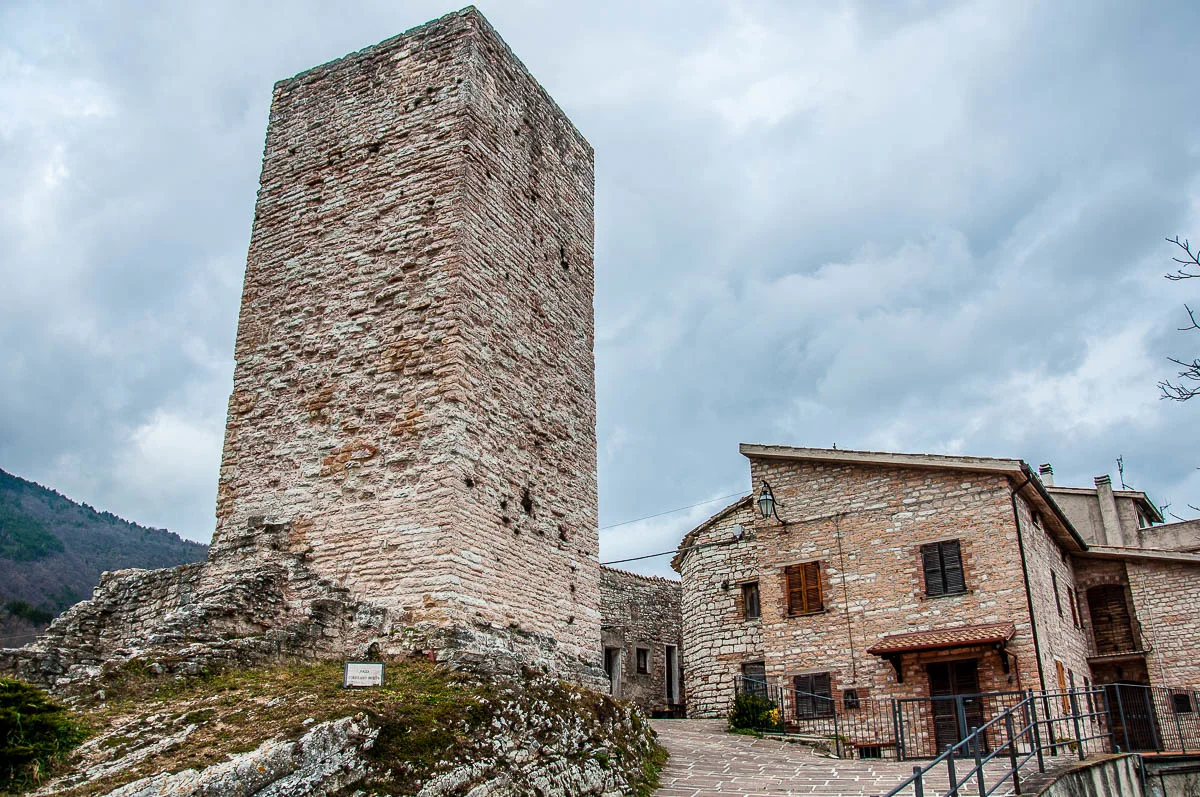
Pierosara is another small hilltop village in the area surrounding the Frasassi Caves.
It’s also one of the best places to spend the night if you are planning to visit the caves early in the morning. In fact, this is just what we did. We booked in a small B&B called Il Bivacco Frasassi. Here is its official page and its Facebook page, if you want to have a look. We enjoyed immensely our stay in the rustic flat on the ground floor of the old stone house.
The B&B’s owners are passionate hikers and rock climbers. They can provide you with lots of priceless information about exploring the area like a local. I particularly loved the hand-drawn map they provide of the Frasassi Gorge and still keep it in my box with mementoes from Italy.
Pierosara itself is tiny and its original name was Castellum Petrosum. It was first established as a fortified castle in the last centuries of the Western Roman Empire. Its function was to protect the area from expected barbaric incursions. The village’s hilltop location was crucial as it allowed to easily keep an eye on both the Rossa Gorge and the Frasassi Gorge.
During the High Middle Ages, Pierosara was ruled first by the Lombards and then by the Franks. Nowadays, the village is still very medieval in look and feel. It has sturdy stone houses, narrow curving streets, a defensive tower from the old castle, and a couple of centuries-old fortified gates that are still standing on.
Its current name, the village of Pierosara owes to a local legend that tells of a tragic love story. Sara was a beautiful girl who lived in Castellum Petrosum. Piero – a local young man – was in love with Sara and his love was reciprocated. Piero and Sara were betrothed. Unfortunately, the feudal lord of a nearby castle saw Sara and desired her for himself. One night he managed to enter the fortified village and tried to kidnap her.
The villagers closed the gates of the wall that at the time surrounded the village fully and fought to save Sara. The feudal lord – not wanting to declare defeat – killed her cruelly. Piero attacked him but the lord mortally wounded him with an axe. Piero died next to Sara holding her body in a tight embrace with his last strength.
Since that day, the village was known as Pierosara in memory of their tragic love.
13. Other Caves in the Area
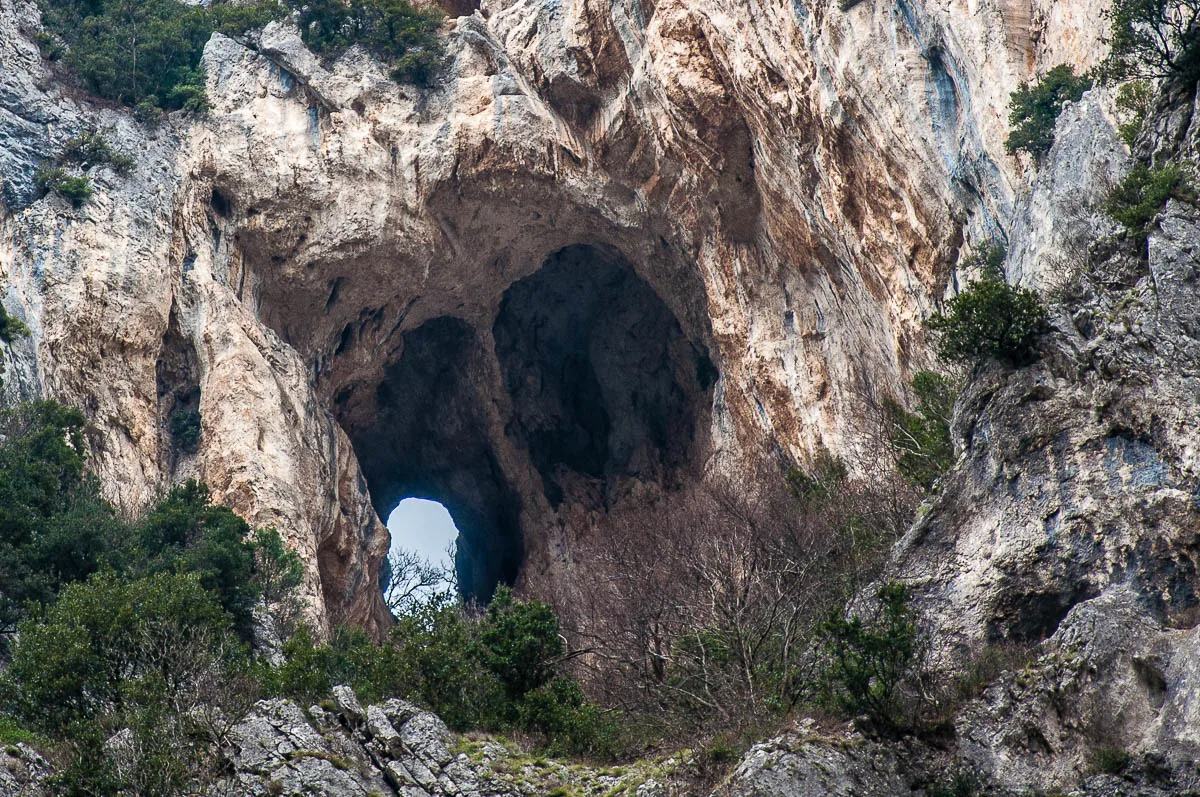
In an area with over 100 caves and cavities, there are several possibilities to visit a few more of them beyond the Frasassi Caves and the Cave of the Blessed Virgin of Frasassi (see point 9 above). Hiking paths pass by several of them with the most popular being the Mezzogiorno Cave, the Baffoni Cave, and the Foro degli Occhialoni.
The Mezzogiorno and the Baffoni Caves have both been frequented by people from the Copper to the Roman Ages. During the Bronze Age, both were used as dwellings. Archaeological research has led to the discovery in the caves of fine ceramics in the shape of bowls and plates.
For specific hikes in the area, please, have a look at the official website of the Gola della Rossa and Frasassi Regional Nature Park. It’s in Italian, so you can use Google Translate to orient yourself. In addition, you can ask for maps, directions, and guides at your accommodation and the local tourist offices.
Please, exercise maximum caution and common sense when out hiking. Don’t enter caves and cavities without proper equipment, caving skills, and a local guide.
In Conclusion
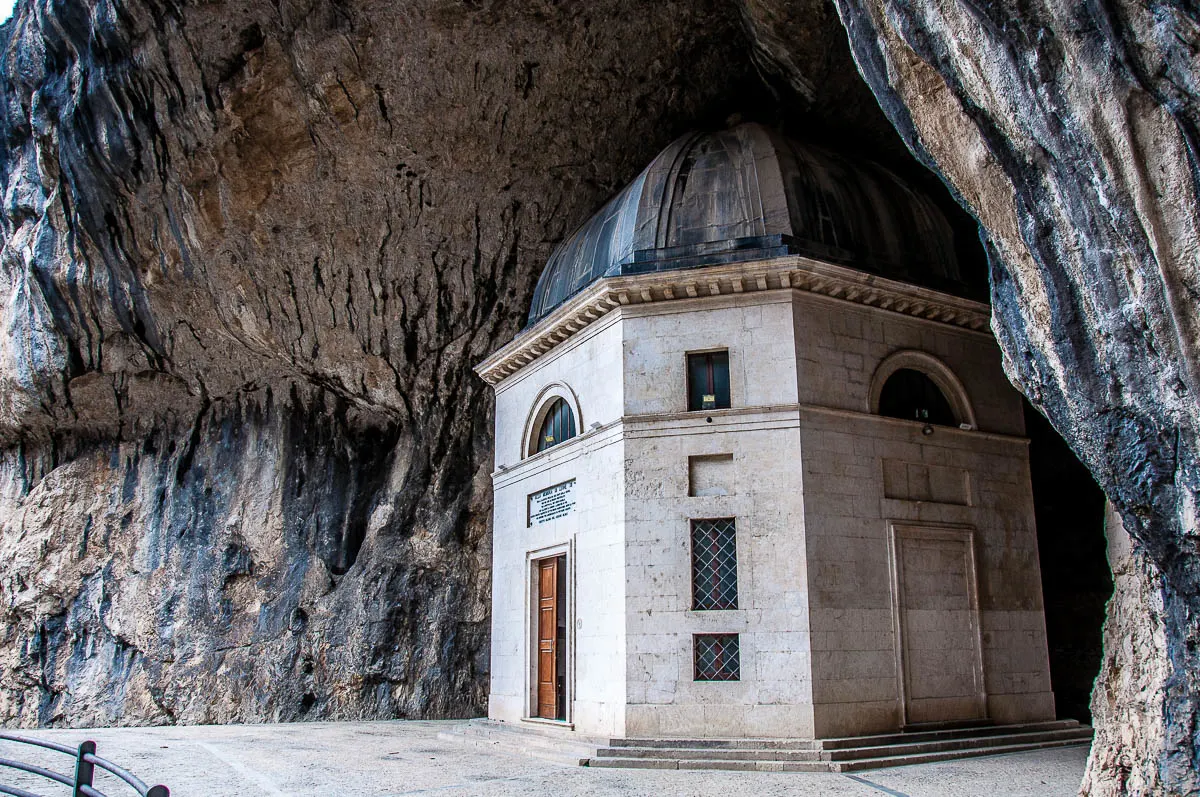
The Frasassi Caves are a beautiful karst cave system in the Central Italian region of the Marche. They are a must-see, especially if you love nature and/or want to experience Italy off the beaten track.
The best thing about the Frasassi Caves though is that the area around them is rich in sights and places of interest. You can spend a wonderful day there or stay longer in order to experience everything this lush and yet little-known corner of Italy has to offer.
From beautiful nature to centuries-old walled villages, from medieval churches and a thousand years old hermitage to a temple built in a cave, from spa procedures at the spot where the ancient Romans would enjoy baths and treatments to small museums that are rich in archaeological, paleontological, and artistic artefacts, the area around the Frasassi Caves offers endless discoveries.
In the above blog post, I share with you the 13 best things to do around the Frasassi Caves.
I hope that you will find the detailed information helpful and that before long you will be heading there to experience everything that the caves and the adjacent area have to offer to the curious traveller.
Enjoy your visit to the Frasassi Caves and the many sights in the area around them!
More Helpful Links
- Italy’s Stunning Frasassi Caves – A Must-See Wonder of Nature
- Marche, Italy – 6 Reasons to Visit Italy’s Most Underrated Region
- 18 of the Best Cities to Visit in Northern Italy (With Travel Tips and Nearest Airports)
- 10 Best Cities in Veneto, Italy to Visit and What to See in Each
- 12 Best Towns to Visit around Lago di Garda – Italy’s Largest Lake
Thank you for reading! Please, leave me a comment, pin the image below or use the buttons right at the top and at the end of this blog post to share it on social media.
For more useful information like this, please, like my blog’s page on Facebook and subscribe to my strictly no-spam newsletter.
